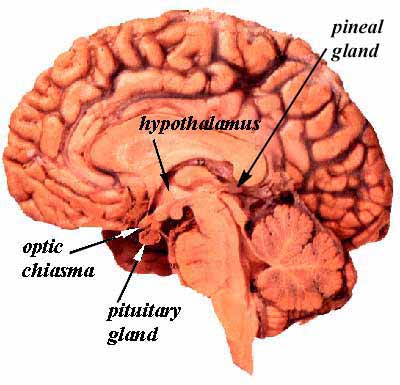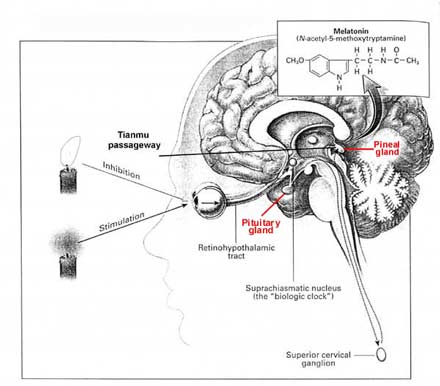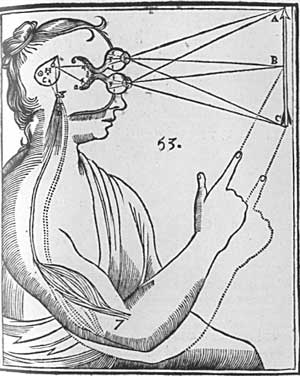The Pineal Gland

The pineal
gland, a cone-shaped organ, which btw is how it got its name,
is about the size of a pea and is located in a tiny cave behind
and above the pituitary gland almost directly in the middle of
the brain.
It is attached to the third ventricle of the brain and produces the hormone
"melatonin," which is secreted throughout the night with
the absence of light.
When light enters the retina of the eyes, this signal is sent
through the optic nerve to a region of the hypothalamus called
the suprachiasmatic nucleus. This pathway is called the retinohypothalamic
tract. From the suprachiasmatic nucleus, nerve impulses via the
sympathetic nervous system travel to the pineal gland and inhibit
the production of melatonin. At night, these impulses stop (because
no light stimulates the hypothalamus) and melatonin production
ensues and is released into the body. As a result, it appears the pineal
gland is a photosensitive organ. Or is it?

Melatonin
is implicated in many human activities, and perhaps human behavioral
disorders.
Melatonin regulates the human daily body rhythms, most notably
the day and night cycle, and perhaps the depression and tiredness
some people feel during long periods of overcast skies and short
days during the winter months is in response to an over production
of melatonin? If this is true, I wonder how melatonin production
effects blind people? Are blind people more susceptible to depression
because of a melatonin imbalance?
Melatonin can be found throughout the animal kingdom. In reptiles and birds,
the pineal gland is found close to the skin; it needs no interaction
with with the eye to sense whether it is day or night. Interestingly
enough, this is where the term "third eye" originated. The pineal gland is
therefore the master clock for these animals. For mammals, however,
the pineal gland is subordinate to the eye and the suprachiasmatic
nucleus because light severely stops the production of melatonin.
Medical
dissection has revealed that the front section of the pineal
gland is equipped with the complete structure of a human eye.
Since it grows/exists inside the human skull, it has been called
a vestigal eye.
Conventional
theory has it that the rod and cone photoreceptors in the retina
are responsible for transmitting all photoreceptive input, and that the suppression
of melatonin (produced by the pineal gland) is also carried out
via this pathway. But,
since the pineal gland is concealed in the skull, how in the
world is it possible for it to respond directly to light??
Bottom line: The
conventional visual pathway from the retina to the pineal gland
via retinal photoreceptors or optic transduction does NOT seem
to be the mode of communication. So then how does the presence of light
reach the pineal gland?
Talk of "unconventional photoreceptors" proposed non-rod
and non-cone photoreceptors carrying non-image/non-visual optical
signals. But evidence to support such a theory is absent.
Another theory proposes that because the structure of the retina
and pineal gland are similar, perhaps the pineal consist of a
variety of genes that are only expressed in the eye; therefore,
the pineal gland has photoreceptors and a complete system for
optical transduction. In other words, there IS
some light-communication highway to the pineal gland. But what
is it??
Ah-ha! Perhaps there is a secret, "unknown" (invisible?)
passageway that allows the mammalian pineal to detect light directly!
Imagine that!
Before we go any further, please read below an interesting medical case
you should know about:
"Until
a few decades ago, scant attention was paid to the pineal gland.
Then came the case in which a child was brought to a German clinic
suffering from eye trouble and headaches. He was five-years-old
and very mature, and apparently had reached the age of adolescence.
"He was abnormally bright mentally, discussing metaphysical
and spiritual subjects. He was strongly group-conscious and only
happy when sharing what he had with others. After his arrival
at the clinic, he rapidly grew worse and died a month later.
An autopsy revealed a tumor of his pineal gland." -
Berman, Lous, M.D., The Glands Regulating Personality
Think about the above story. Other than the fact the pineal gland is effected
by light and secretes melatonin, scientist and medical professionals
really do NOT understand EXACTLY what the function of the pineal
gland is!
Okay, fine. But have any of you began to tie in the physical,
bodily human death with this light funtioning gland? No? Not
yet? Okay, no problem. Please read on :-)
Now, there has been some confusion as to what the human "Third
Eye" is and where it is located. This confusion seems to
stem mostly from the location of the pituitary and pineal gland
and the similarity of their names.
The "magical" Third Eye and the Ajna chakra have been
mentioned in many religions as dwelling between the eyes, eyebrows,
center of the forehead, etc., and its association with light.
In the 2nd century, Galen was the first to mention the Third
Eye to the West. He believed it to be a valve that regulated
thought.
18th century
French scientist and philosopher Rene Descartes believed it was
the chief interpreter of vision and the "seat of the human
soul."

In 1644, Descartes' theory of vision and interaction with the
pineal gland is expressed in this woodcut. He believed light
particles interacted with the eyes and the image seen (the light
particles themselves) were then transmitted to the pineal gland
- the pineal gland being the nexus between the mind and the body.
"In man, soul and body touch each other only at a single
point, the pineal gland in the head."
This drawing depicts an external stimulus being transmitted into
an act of will by pointing, an act sent by the pineal gland.
SOURCE:
www.princeton.edu
In 1918, Nils Holmgrenin, a Swedish anatomist, referred to the
pineal gland as the "Third Eye" because he discovered
cells that looked very much like retina cone cells in the tip
of the gland in frogs and dogfish sharks. AND, recent discoveries
have found that the pineal gland in the Western Fence Lizard
contains a photo-receptive element scientist called a "third
eye" that protruded from the top of its head. Interesting.
- SOURCE: www.suneye.org
Now
let me ask you a very interesting question: While napping or just falling asleep,
have you been able to see the room you are sleeping in, or room(s)
of your house/apt while your eyes have been closed?! You feel,
you KNOW
your eyes are closed, yet you can see as if your eyes were open!!!??
Are you with me?
It has
been said that the "Third Eye" is a direct doorway
to your subconscious, or unconscious mind. This may be true. The Ancient Egyptians studied this gland
and understood its paranormal power. The headdress with the cobra snake protruding
from the forehead exemplifies this symbology. And it is said that the Eye of Horus
and the Masonic Capstone on the top of the pyramid on the Great
Seal of the U.S. dollar bill represents this understanding as
well.
When activated, the pineal gland opens our subconscious and
6th sense and becomes the window, or doorway to the higher planes
(realms).
It has been
said that during the day, the pineal gland synthesizes amino
acids into serotonin, which is converted into melatonin at night.
The pineal gland also produces pinoline. When pinoline interacts
with serotonin, we fall into the state of consciousness called
the dream state. This occurs about 2 hours after going to sleep.
Esoteric
schools have long known that this area of the brain is the connecting
link between the physical and spiritual worlds. Development of
psychic abilities has always been closely associated with the
pineal gland.
The Crown
Chakra reaches down until its vortex contacts the pineal gland.
Prana is received, and with practice, the vibrational level of
the astral body is raised and allowed to separate from the physical
body. This is what is known
as Astral Projection.
Once you learn how to activate and use this wonderful "Third
Eye," you will perceive higher dimensions that will astound
you. In order for this to happen however, a proper relationship must be established
between your pituitary gland (personality) and your soul (operating
through your pineal gland ). Once this relationship is established,
a magnetic
field is created between the two glands, uniting the positive
and negative forces to create the "light in the head."
Once this "light in the head" is activated, the astral
body can leave the physical body.
It should be noted that you will never realize any of this until
you have properly prepared yourself. This preparation takes time,
effort and DESIRE. I offer many exercises that are designed simply
to HELP you attain this higher level of spiritual education,
so to speak, but the end result is and always will be completely
up to you.
For now, this is all I will say about that.
<<Back